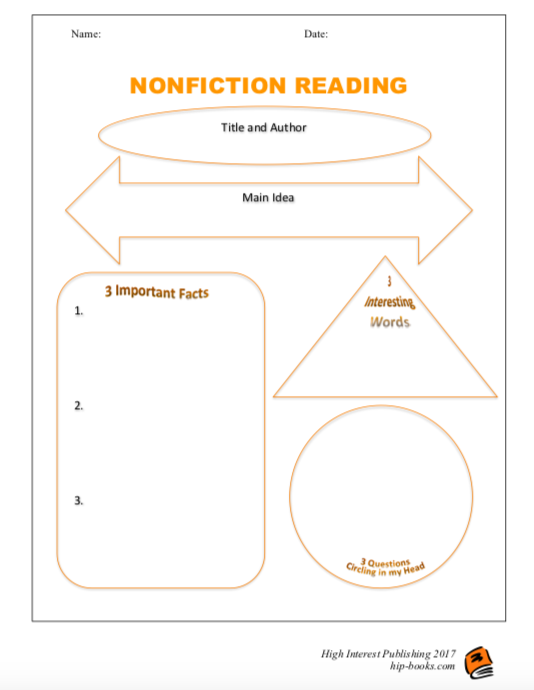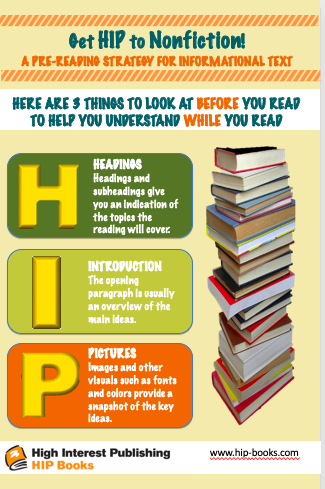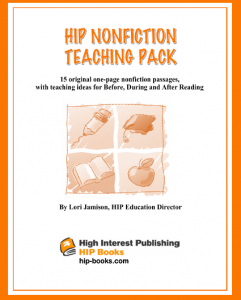
66-page HIP NONFICTION TEACHING PACK
15 original, one-page nonfiction passages
Everything you need for Before, During and After Reading for independent, online or teacher-directed learning
Not available for sale. Complimentary on request with HIP orders over $200*.
NAVIGATING NONFICTION TEXT

If we want our students to become better readers, they need to have plenty of practice with easy texts and instructional support with texts that stretch them as readers.
In the ELA classroom, it’s easy to find reading materials at a range of reading levels. But in the content areas – Science, Social Studies, Health, the Arts, etc. – there are often limited reading choices at easier levels.
For many readers, especially boys, nonfiction is the preferred reading genre. Then why is informational text more challenging for so many readers? Density of information, unfamiliar concepts, technical vocabulary and unique text structures and page layouts make nonfiction more challenging than narrative text. Add to that the fact that textbooks are often written at least two grade levels higher than the grade for which they’re designed! That’s why we need to give the students a repertoire of tools for accessing difficult informational text, as well as other forms of nonfiction.
Read more about WHAT TO DO IF THEY CAN’T READ THE TEXTBOOK.
CHALLENGES OF NONFICTION TEXT
- Density of information
- More formal language
- Nonlinear text
- Technical vocabulary
SUPPORTS IN NONFICTION TEXT
- Visuals
- Vocabulary supports
- Headings and Topic Sentences
- Organizers (Index, Table of Contents)
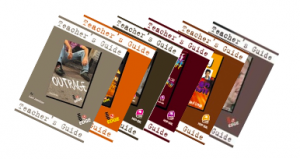 Although High Interest Publishing is known for its exciting hi-lo fiction, we recognize that students must read nonfiction as well. Nonfiction engages readers, invites their wonderings, answers their questions and helps them understand the world around them. From a pedagogical perspective, nonfiction helps build vocabulary and background knowledge to support other reading. That’s why every HIP TEACHER’S GUIDE contains a nonfiction article to complement the novel, in order to build background knowledge and to generate interest in the book.
Although High Interest Publishing is known for its exciting hi-lo fiction, we recognize that students must read nonfiction as well. Nonfiction engages readers, invites their wonderings, answers their questions and helps them understand the world around them. From a pedagogical perspective, nonfiction helps build vocabulary and background knowledge to support other reading. That’s why every HIP TEACHER’S GUIDE contains a nonfiction article to complement the novel, in order to build background knowledge and to generate interest in the book.
NONFICTION TEXT FORMS
INFORMATIONAL TEXT
FUNCTIONAL TEXT
Although Informational reading is ubiquitous in the academic world of adolescents and teens, it’s not the only kind of nonfiction. FUNCTIONAL TEXT is material that enables us to function in the world: advertisements, schedules, menus, instructions, recipes, to name a few.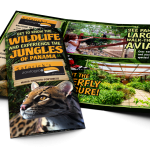
Reading Posters and Flyers
Reading and Writing Brochures
TEACHING NONFICTION TEXTS
MAPPING THE PAGE
Navigating nonlinear text can be challenging for readers because it is not intended to be read top to bottom and left to right. Mapping the page teaches them to highlight every chunk of information to ensure that they don’t miss key details.
1. Provide an infographic or other piece of visual text, such as the example on the right. Ask students to identify where the key information is found. Use a model such as the Mapping the Page Powerpoint to demonstrate how to draw circles, boxes or other shapes around chunks of information. Talk with students about the highlighted information:
- What different formats does the information take?
- Where are the different chunks of information on the page?
- Do the visuals repeat, extend or tell different information than the text?
- Which chunks of information do you notice first? Next? Do you think it’s the most important information?
- Was there any information you didn’t notice on the first reading?
- How did the visual features influence the order in which you read the information?.
2. Provide students with their own copies of an infographic. Have them clip a piece of acetate (such as an overhead transparency) to the page and use skinny markers to draw circles, boxes or other shapes around each chunk of information.
3. You might have students check off each shape on the acetate as they read each section. Older students might be asked to write a one-sentence summary in each shape.
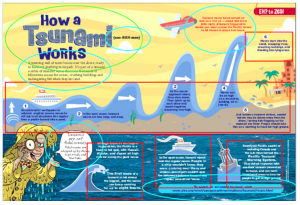
Download a “Mapping the Page” Powerpoint Demonstration.

CHUNK AND CHEW
Chunking is a process of breaking up information into manageable segments. When students have opportunities to pause and process chunks of information, they are more likely to understand it more deeply. You can read more about this strategy in this article Chunk and Chew: Giving Learners Processing Time.
Although this strategy is generally applied to explicit teaching, it can also be used with reading. Teach students to Chunk and Chew by giving them small bits of text to read, then providing a minute or two to reflect or “chew on” the information. Model the strategy by displaying short sections of text and thinking aloud to summarize or note key ideas. Provide guided practice by displaying chunks of text and having students talk to a partner what they remember or learned. Ultimately, students should be able to chunk their own reading and monitor their own comprehension.
Research shows readers remember and comprehend better when they write about their reading. Add a writing component by having students STOP & JOT. When they pause after reading a chunk of information, they jot a few notes about what they’ve learned.
LET’S NOT FORGET ABOUT WRITING!
Knowing how to conduct research and write about one’s findings is an essential skill for school and for life. Click here to read more about 7 STEPS TO WRITING A RESEARCH REPORT.


